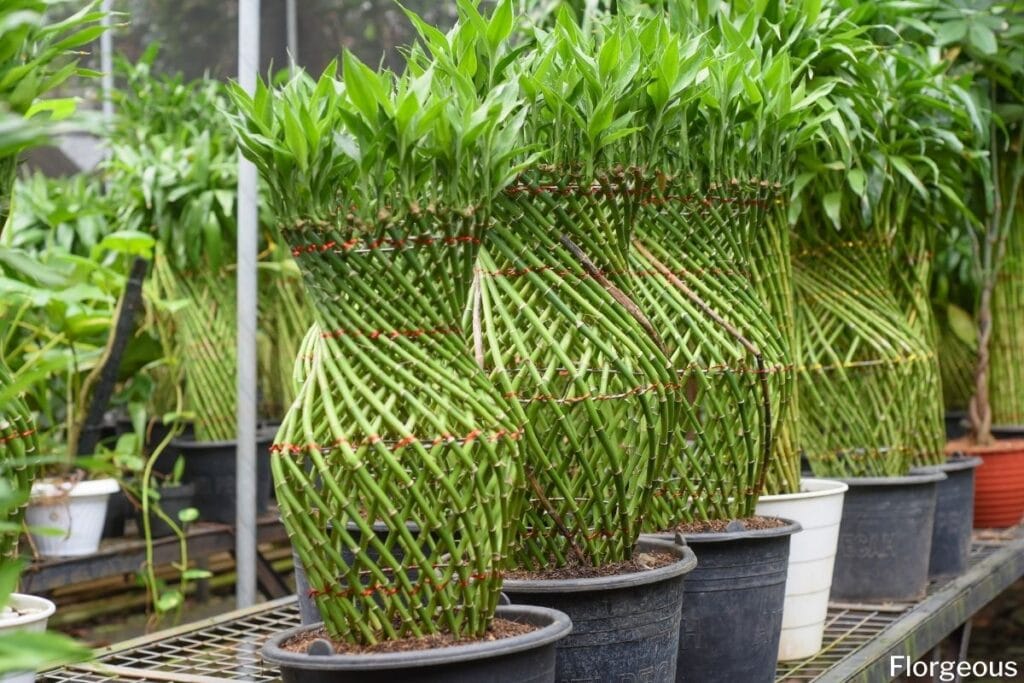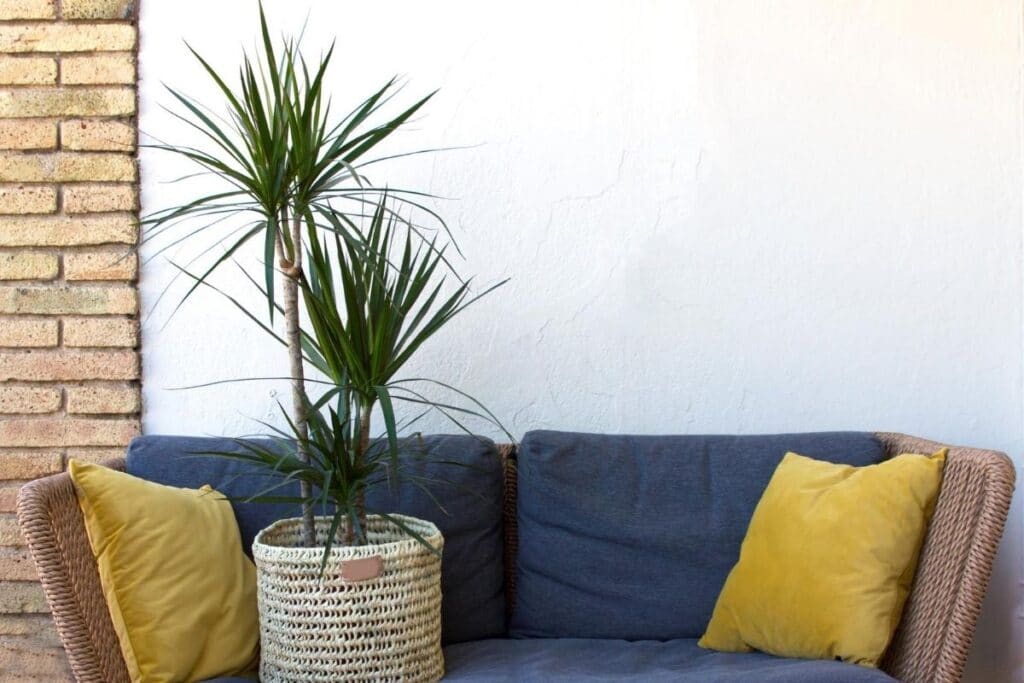The leaves look just like sweet corn, but this isn’t a plant you’ll want to grow in your vegetable garden. Instead, the dracaena plant is one that is perfect for adding a tropical flair to your home as a houseplant.
The good news? If you’re looking for information on how to grow and care for dracaena plants, you’re in the right place.
From Corn Plant to Lucky Bamboo, and even your favorite Snake Plant, dracaena has always been a mainstay to most ornamental house plant collections due to its sculptural strap-like foliage that gives a bold but inviting accent to any space. Even for new houseplant enthusiasts, you can never go wrong with these undemanding gems.
Dracaena genus has more 100 trees and succulent shrubs under the family Asparagaceae, subfamily Nolinoideae. From the Greek word drakaina or “female dragon”, Dracaena has a red resinous sap that is likened to a dragon’s blood.
Most species are native to the tropical regions like Africa, South Asia and Central America so they can stay fairly dry for long periods. With the hardiness of 10b-11, some species can even tolerate more cold.
Let’s dive in to get a better understanding of how to grow and care for dracaena indoors.
Plant Facts
| Scientific name | Dracaena |
| Common names | Corn plant, dragon tree, etc |
| Family | Asparagaceae |
| Plant Type | Houseplant |
| Height and Width | Varies by species; 2-10 feet tall, up to 2 feet wide indoors |
| Origin | Africa and southern Asia |
| Flower colors | N/A |
| Foliage color | Green, sometimes striped |
| Sun Exposure | Indirect light |
| Soil Type & pH | Acidic-Neutral pH |
| Special features | Strap-shaped foliage (often striped), grows well in indirect light and low light conditions |
How to Grow Dracaena Plant
Dracaenas are rugged, easy-to-care-for houseplants that lend a tropical appearance to any setting. They are often grown in home and office settings since they can tolerate low light conditions.
Propagation
Most dracaena plants are propagated by cutting and division. And the best time to propagate dracaena is during its early growth cycle in spring and summer.
Some tips on successfully propagating dracaenas are dipping the cuttings in rooting hormone to encourage early root formation and once planted, enclosing the set up in a plastic bag to regulate temperature and humidity. After 4 to 6 weeks, the plant should show new signs of plant growth and is ready to be moved indoors.
Soil
Grow your plant in a standard commercial houseplant potting mix. It should be well-draining and allowed to dry out between waterings.
Pruning
Pruning is not necessary for dracaena but it can be done to encourage more consistent, uniform growth. If you notice that the stems of the plant become too long or bare-looking, you can cut them to the desired height. New leaves will soon appear in their place.
You can also prune for the purpose of propagation. Take tip or stem cuttings for best results. One more option is to train your plant. Training works especially well for larger dracaena varieties, like the dragon tree. You can train the stems into different shapes to give it a more architectural or Asian feel.
Repotting and Transplanting
You can report whenever your shrubby plant begins to lift itself out of the container. This can also be done when the roots start coming out of the drainage holes.

Dracaena Plant Care Tips
Aside from giving a robust and tropical vibe, some dracaena plants are also noted as effective in removing air pollutants which make them good indoor plants for office and home. It helps in removing benzene, trichloroethylene, formaldehyde, xylene, toluene and carbon dioxide.
Some believe that dracaena plants can bring good luck (Lucky Bamboo) and others even used them in rituals and peace-making ceremonies a few centuries ago.
Dracaena houseplants are also used in veterinary medicine. However, the saponin compounds in the plants are toxic to household pets like cats and dogs. When ingested, it can result in vomiting, diarrhea, drooling or loss of appetite. (2)
It is best to place your dracaena plants outside of your pets’ reach to avoid this. If ever this accident occurs, make sure to contact your veterinarian as soon as possible.
Water
Allow the surface of the soil to dry out before watering thoroughly. Overwatering these tropical broadleaf evergreen shrubs will cause the root to rot. Mist regularly as inadequate water or dry humidity may cause brown tips and spots on the leaves. You can improve the humidity by placing the plant on water-filled pebble trays.
Make sure you don’t allow the indoor dracaena plants to sit in water for too long. While many growers are tempted to place their dracaenas in a saucer of water to increase humidity levels (more on this humidity requirement later in the article), you need to be very careful doing this in direct water as it can rot the roots.
Finally, when you water, be sure to use warm water. Make sure the water is at least room temperature and not too cold.

Sunlight
Most dracaenas will grow their best when given filtered or bright indirect light daily, while some are more tolerant of lower lights. When a plant growing in a dim light has been moved to a brighter location, the new leaves will be thicker and sturdier.
Consider moving the tropical plants further to the light source if you notice pale, dry patches on the leaves. The best light condition gets two or three hours a day of sunlight filtered through a translucent blind or curtain.
Temperature and Humidity
Dracaenas are best grown between 65° to 80°F. At temperatures below 65°F, very little growth will occur, and below 55°F might cause chilling damage to the plant when exposed to wind. Avoid drafts and keep the plant away from cold windows.
This is a plant that needs to be kept somewhat humid. You can cut back on the water during the winter but will need to continue misting it to maintain humidity. The leaves of this plant often turn brown at the tips when indoor humidity is too low – again, something that is much more common in the winter.
Fertilizer
Feed your dracaena plant once or twice a month during the growing season. Use a liquid foliage fertilizer for this. You can also use time-release fertilizer pellets or organic options like compost tea if you choose.
Pest and diseases
Plant diseases or insects that could cause serious problems to Dracaena plants very rarely occur. But you should still watch out for thrips, scales, shore flies or mealybugs which can stunt the growth of your indoor plants.
Brown tips or spots can be a sign of inadequate watering or dry humidity. Root rot can be caused by overwatering or lack of proper drainage. Additionally, keep an eye out for yellow leaves or foliage turning yellow, as this can also indicate stress or other issues affecting your Dracaena.
Dracaena is very sensitive to fluoride. Avoid using fertilizer that is high in superphosphate and other phosphorus sources containing fluorides. Tap water may also include fluoride, so it would be best to use purified water. Maintain soil pH between 6.0 to 6.5. High pH of 7.5 to 8.0 may result in iron chlorosis. (3,4,5)
Common Dracaena Plant Varieties and Cultivars
There are many different types of dracaena plants you can grow. Some of the most popular include:
Corn Plant (D. fragrans)
This is one of the most famous types of dracaena. It gets its name from the corn-like look of the elegant leaves. Within this species, there are several different cultivars you can grow, including ‘Rothiana,’ ‘Lindenii,’ and ‘Massangeana.’ Of these, ‘Massangeana’ is the most common, with glossy green, yellow-striped leaves.
Dragon Tree (D. marginata)
The dragon tree can grow up to ten feet tall and is one of the largest types of dracaena plants out there as a result. To force it to branch, you can cut back the stems (something that also encourages it to grow in a more compact fashion indoors). This is a type of dracaena plant that is often grown in homes and offices because it handles low light conditions with ease.
There are several cultivars you can grow, too, including ‘Tricolor.’ This is a variety with red and cream-colored stripes on narrow leaves.
Gold Dust Dracaena (D. godseffiana)
This plant is named for its creamy yellow speckles that appear on the leaves. These do eventually fade back to white as the plant gets older, but it’s beautiful to behold nonetheless. It’s a small, compact plant that looks much like a shrub, growing only to two or three feet tall. ‘Florida Beauty’ is one popular cultivar.
Green Dracaena (D. deremensis)
This plant isn’t as common as some of the other cultivars, but it’s still possible to find in most places. Popular cultivars include ‘Janet Craig,’ ‘Compacta,’ ‘Bausei,’ and ‘Warneckii.’
Pleomele (D. reflexa)
Last but not least is pleomele. Dracaena reflexa has flexible stems and dense foliage – foliage that becomes even more dense and compact if grown in enough light.
FAQs
Does dracaena need sunlight?
Dracaena plants prefer bright, indirect sunlight but can tolerate low light conditions. Avoid placing them in direct sunlight, as it can scorch their leaves.
Should I cut the brown tips off my dracaena plant?
Yes, you can trim the brown tips off your dracaena plant using clean, sharp scissors or pruning shears. This helps improve the appearance of the plant and prevents further browning. Ensure you cut just the browned portion, leaving the healthy green parts intact.
Do brown tips mean overwatering?
Brown tips on dracaena leaves can indicate various issues, including overwatering, underwatering, low humidity, or excessive fertilizer salts. While overwatering is a common cause of brown tips, it’s essential to assess the plant’s overall care and environment to determine the exact cause.
Do you water dracaena from top or bottom?
Water dracaena plants from the top, thoroughly saturating the soil until water drains out of the bottom of the pot. Allow excess water to drain away, and empty the saucer beneath the pot to prevent waterlogging. Avoid watering from the bottom, as this can lead to waterlogging and root rot.
Conclusion
As you can see, dracaena is a houseplant that is not difficult to grow in the slightest. Although there are some quirks you’ll need to pay attention to, this is a hardy houseplant that can thrive in just about any home.
References
Reference list:
Clemson Cooperative Extension: Dracaena
https://hgic.clemson.edu/factsheet/dracaena/
NC State Extension: Dracaena marginata
https://plants.ces.ncsu.edu/plants/dracaena-marginata/
NC State Extension: Dracaena fragrans
https://plants.ces.ncsu.edu/plants/dracaena-fragrans/
University of Vermont: Easy Houseplants – Dracaena
https://pss.uvm.edu/ppp/articles/dracaena.html
Texas Tech University: Dracaena
Close
*Photo by AssiaPix/depositphotos







